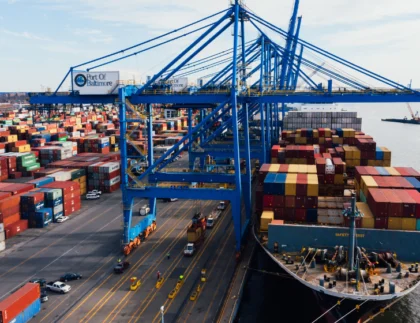
In today's competitive global business scene, attaining complete visibility in freight operations is vital for a business to remain competitive.
With such an approach, an organization can manage every aspect of the supply chain, from the delivery of goods to the actual shipment, enabling companies to overcome challenges and improve operations efficiently.
What is End-to-End Visibility?
End-to-end visibility refers to the capability of monitoring and tracking goods throughout the entire supply chain. When considering all factors involved, it is easier for businesses to foresee interruptions, improve their routes, and improve efficiency.
By incorporating GPS tracking, RFID technology, and cloud services, companies can access invaluable insights and data, which enhances decision-making and operational flexibility.
The Importance of End-to-End Visibility in Modern Logistics
As global supply chains become more complex, the need for end-to-end visibility has never been more critical. Businesses face numerous challenges, including unexpected delays, regulatory compliance, and fluctuating demand.
With a transparent supply chain, companies can identify and mitigate risks early, optimize inventory management, improve customer satisfaction through accurate delivery timelines, and reduce operational costs through efficient route planning.

Leveraging Logistics Data Tracking for Enhanced Operations
Logistics data tracking activities include gathering and studying information connected to product transfers. This information consists of a summary of shipment transfers, how long the shipment takes, and what deal is made with the shipment.
Businesses can use this information to find areas to save money by optimizing routes and reducing expenditures. Another key feature of sophisticated analytics is the ability to predict delays. This allows businesses to make proactive efforts to avoid unneeded complications.
Companies can achieve some benefits through effective logistics data tracking, such as real-time shipment monitoring, predictive analytics for demand forecasting, enhanced decision-making through data-driven insights, and improved coordination between supply chain partners.
Achieving Supply Chain Transparency
Supply chain transparency makes all aspects of the supply chain visible to stakeholders, including suppliers, partners, and customers. This openness fosters trust, ensures compliance with regulations, and enhances brand reputation. By providing stakeholders access to relevant information, companies can improve collaboration, streamline processes, and respond more effectively to market demands.
Real-time visibility into shipment status, clear communication with suppliers and customers, compliance with regulatory standards, and data sharing across supply chain networks are essential elements of supply chain transparency.
Implementing Complete Freight Tracking
Complete freight tracking ensures that shipments are monitored from origin to destination at every stage. This comprehensive tracking minimizes the risk of lost or delayed shipments and enhances customer satisfaction by providing accurate delivery estimates. IoT sensors and real-time tracking systems are crucial in achieving complete freight tracking, offering visibility into factors like temperature, humidity, and security status.
Integrating GPS and RFID tracking systems, IoT-enabled sensors for condition monitoring, cloud-based tracking platforms, and blockchain for data security and transparency contributes significantly to this process.

The Role of Visibility Technology in Modern Logistics
Visibility technology encompasses tools and systems that provide real-time information about freight movements. These technologies, including GPS devices, RFID tags, and advanced tracking software, enable businesses to monitor shipments continuously. Integrating visibility technology into logistics operations improves efficiency, reduces operational costs, and enhances customer satisfaction.
Examples of visibility technology include telematics for vehicle tracking, AI-driven analytics for predictive insights, mobile apps for real-time shipment updates, and digital twins for supply chain modeling.
Embracing Data-Driven Logistics
Data-driven logistics involves making strategic decisions based on the analysis of logistics data. By harnessing big data and analytics, companies can forecast demand, optimize inventory levels, and enhance route planning. This approach leads to more efficient operations, cost savings, and the ability to meet customer expectations more effectively.
The key advantages of data-driven logistics are enhanced forecasting accuracy, reduced lead times and faster deliveries, data-based performance monitoring, and greater agility in responding to market changes.
Enhancing Customer Visibility
Customer visibility refers to providing customers with real-time information about their shipments. This transparency enhances the customer experience by offering accurate delivery timelines and proactive communication regarding delays. Businesses can build trust, improve satisfaction, and foster long-term loyalty by implementing customer visibility solutions.
Providing real-time tracking through mobile apps, sending automated notifications for shipment updates, offering self-service portals for order management, and ensuring accurate and timely delivery information are effective ways to improve customer visibility.
Promoting Logistics Transparency
Logistics transparency involves openly sharing information about logistics processes with stakeholders. This practice ensures that all parties clearly understand operations, improving collaboration and efficiency. By promoting logistics transparency, companies can identify bottlenecks, streamline workflows, and enhance overall supply chain performance.
Standardizing data collection and sharing practices, implementing collaborative platforms for real-time updates, encouraging feedback from supply chain partners, and ensuring accountability through performance metrics are vital steps to achieve logistics transparency.
Gaining Supply Chain Insights
Supply chain insights are the valuable understandings gained from analyzing supply chain data. These insights enable businesses to identify trends, anticipate challenges, and make informed decisions. By leveraging supply chain insights, companies can enhance forecasting accuracy, optimize inventory management, and improve supplier relationships.
Advanced analytics for data interpretation, monitoring key performance indicators (KPIs), conducting regular supply chain audits, and collaborating with data science teams for deeper analysis are essential for deriving supply chain insights.

The Future of Freight Visibility
The future of freight visibility lies in integrating advanced technologies such as artificial intelligence, blockchain, and IoT. These innovations will enable more accurate tracking, predictive analytics, and enhanced security measures.
As these technologies evolve, businesses that adopt them will be better positioned to navigate the complexities of global logistics and meet customers' ever-increasing demands.
Conclusion
Achieving end-to-end visibility in freight operations is no longer a luxury but a necessity in today's competitive landscape. By embracing logistics data tracking, supply chain transparency, complete freight tracking, and visibility technology, businesses can optimize operations, reduce costs, and enhance customer satisfaction.
The shift towards data-driven logistics and the emphasis on customer visibility and logistics transparency are pivotal in gaining valuable supply chain insights. As technology advances, the companies that leverage these tools will lead the way in efficiency and reliability within the logistics industry.











